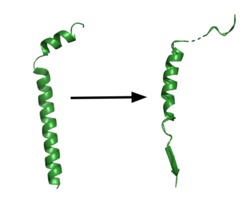Sandbox Reserved 1619
From Proteopedia
(Difference between revisions)
| Line 34: | Line 34: | ||
==Relevance== | ==Relevance== | ||
| - | Gamma secretase has been determined to be highly involved with diseases such as Alzheimer's disease (AD). In this, beta-amyloid build up leads to [https://en.wikipedia.org/wiki/Amyloid amyloid]plaques in brain. These plaques then go on to cause severe neural dysfunction over time. Inhibition of GS could be potential AD treatment, but as stated earlier, this is a hard model to accomplish as the protease is relevant with several different substrates. Complete inhibition would cause other severe implications beyond that of AD, making treatment more difficult than what meets the eye. However, what is known is that there are many different regions that give rise to GS malfunction when they are mutated. Over 200 of these mutations have been linked to causing AD. In particular, these mutations target so called "hot spots" on the enzyme and heavily impact the interface between PS1 and APP, affecting the integrity of catalysis and ultimately creating the plaques that impair neural function. Currently, in order to combat this complex situation, differences in binding between different substrates are being utilized to create drugs that selectively inhibit APP binding with GS, and possibly create a more ideal target for AD treatment<ref name="Zhou">PMID:30630874</ref>. | + | Gamma secretase has been determined to be highly involved with diseases such as Alzheimer's disease (AD). In this, beta-amyloid build up leads to [https://en.wikipedia.org/wiki/Amyloid amyloid]plaques in brain.<ref name="Devendra">PMID:29477076</ref> These plaques then go on to cause severe neural dysfunction over time. Inhibition of GS could be potential AD treatment, but as stated earlier, this is a hard model to accomplish as the protease is relevant with several different substrates. Complete inhibition would cause other severe implications beyond that of AD, making treatment more difficult than what meets the eye. However, what is known is that there are many different regions that give rise to GS malfunction when they are mutated. Over 200 of these mutations have been linked to causing AD. In particular, these mutations target so called "hot spots" on the enzyme and heavily impact the interface between PS1 and APP, affecting the integrity of catalysis and ultimately creating the plaques that impair neural function. Currently, in order to combat this complex situation, differences in binding between different substrates are being utilized to create drugs that selectively inhibit APP binding with GS, and possibly create a more ideal target for AD treatment<ref name="Zhou">PMID:30630874</ref>. |
Revision as of 03:16, 20 April 2020
Gamma Secretase
| |||||||||||
References
- ↑ 1.0 1.1 Yang G, Zhou R, Shi Y. Cryo-EM structures of human gamma-secretase. Curr Opin Struct Biol. 2017 Oct;46:55-64. doi: 10.1016/j.sbi.2017.05.013. Epub, 2017 Jul 17. PMID:28628788 doi:http://dx.doi.org/10.1016/j.sbi.2017.05.013
- ↑ 2.0 2.1 2.2 Zhou R, Yang G, Guo X, Zhou Q, Lei J, Shi Y. Recognition of the amyloid precursor protein by human gamma-secretase. Science. 2019 Feb 15;363(6428). pii: science.aaw0930. doi:, 10.1126/science.aaw0930. Epub 2019 Jan 10. PMID:30630874 doi:http://dx.doi.org/10.1126/science.aaw0930
- ↑ 3.0 3.1 Bai XC, Yan C, Yang G, Lu P, Ma D, Sun L, Zhou R, Scheres SH, Shi Y. An atomic structure of human gamma-secretase. Nature. 2015 Aug 17. doi: 10.1038/nature14892. PMID:26280335 doi:http://dx.doi.org/10.1038/nature14892
- ↑ Bolduc DM, Montagna DR, Seghers MC, Wolfe MS, Selkoe DJ. The amyloid-beta forming tripeptide cleavage mechanism of gamma-secretase. Elife. 2016 Aug 31;5. doi: 10.7554/eLife.17578. PMID:27580372 doi:http://dx.doi.org/10.7554/eLife.17578
- ↑ Kumar D, Ganeshpurkar A, Kumar D, Modi G, Gupta SK, Singh SK. Secretase inhibitors for the treatment of Alzheimer's disease: Long road ahead. Eur J Med Chem. 2018 Mar 25;148:436-452. doi: 10.1016/j.ejmech.2018.02.035. Epub , 2018 Feb 15. PMID:29477076 doi:http://dx.doi.org/10.1016/j.ejmech.2018.02.035
Student Contributors
Layla Wisser
Daniel Mulawa

